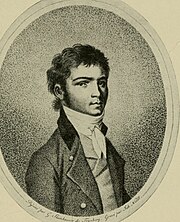| String Quartet | |
|---|---|
| No. 2 | |
| Early string quartet by Ludwig van Beethoven | |
 Ludwig van Beethoven, c. 1796 | |
| Key | G major |
| Opus | 18, No. 2 |
| Composed | 1798–1800 |
| Dedication | Joseph Franz von Lobkowitz |
| Published | 1801 |
| Movements | Four |
The String Quartet No. 2 in G major, Op. 18, No. 2 (actually his third), was written by Ludwig van Beethoven between 1798 and 1800 and published in 1801, dedicated to Joseph Franz von Lobkowitz.
It consists of four movements:
- Allegro (G major)
- Adagio cantabile – Allegro – Tempo I (C major)
- Scherzo: Allegro (G major)
- Allegro molto, quasi presto (G major)
Of the Op. 18 string quartets, this one is the most grounded in 18th-century musical tradition.[1] According to Michael Steinberg, "In German-speaking countries, the graceful curve of the first violin's opening phrase has earned the work the nickname of Komplimentier-Quartett, which might be translated as 'quartet of bows and curtseys'."[2]
The nickname may have originated from one of Haydn's last string quartets written about the same time (Op. 77, No. 1, Hob. III:81; 1799), which was also known as the Komplimentier-Quartett. Haydn was Beethoven's teacher at the time, and there are similarities in style between the two quartets. They are also both in the key of G major.[3]
After he finished the quartet, Beethoven was not satisfied with the second movement and wrote a replacement. Sketches of the original slow movement survive and a complete version has been reconstructed by musicologist Barry Cooper.[4] It was performed publicly, possibly for the first time, by the Danel Quartet in the Cosmo Rodewald Concert Hall at the Martin Harris Centre, University of Manchester, on 30 September 2011.[citation needed]
- ^ Winter & Martin 1994, p. 155.
- ^ Winter & Martin 1994, p. 156.
- ^ "The string quartets of Joseph Haydn", Banat Blog (in German), 19 April 2009. Retrieved 10 September 2011. [dead link]
- ^ " 'Lost' Beethoven work to be aired", BBC News, 28 September 2011, retrieved 12 October 2011.